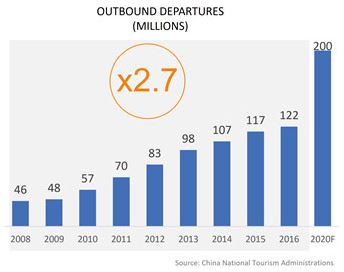
How many Chinese tourists will spend their New Year celebrations in Namibia?

A report released this week by ForwardKeys indicates that China is fast becoming the world’s most important feeder territory for international tourism. Following visa relaxation in many countries, a spectacular increase in the number of Chinese visitors has resulted. The report forecasts that in a mere three years, by 2020, Chinese outbound travellers will top the 200 million mark.
Speaking at the recent World Bridge Tourism conference in London, the Chief Marketing Officer at FowardKeys, Mr Laurens van den Oever said “The Chinese dragon is breathing more hotly than ever. Bookings for outbound travel during Chinese New Year in February 2018, are currently 40% ahead of where they were at the same time last year.” Looking at a broader period, from the beginning of November until the end of February, bookings are also strongly ahead. The destinations which currently look set to enjoy the most positive growth are: Thailand, where Chinese bookings are currently 47% ahead of where they were at this point last year, Vietnam, 40% ahead, France, 31% ahead, Singapore 28% ahead, Japan 27% ahead and Canada, 23% ahead.
ForwardKeys said that the growth story has been running for a number of years and the long-term trend shows no indication of slowing. According to the Chinese National Tourism Administration (CNTA), outbound travel has grown 270% since 2008 and it is forecast to reach 200 million departures by 2020.
Expenditure by Chinese tourists has grown even more strongly. From 2008, it has grown 730%. The management consultancy McKinsey estimates that Chinese spending on luxury goods has been growing at 9% per annum, whereas the average for the rest of the world has been growth at 3% per annum.
The strong growth in expenditure by Chinese tourists has not been overlooked by destinations, keen to attract the tourism yuan. Since 2014, over a dozen countries have changed their visa rules to encourage Chinese tourists to come and the impact has been dramatic. In the six months following the relaxation of visa requirements, arrivals in Morocco increased 378%. Other spectacular increases included Moldova, up 253%, Tunisia, up 240%, Serbia up 180%, Israel up 57%, Peru up 56% and Chile up 49%.
Where the Chinese decide to visit can be strongly influenced by geopolitical events. The stationing of the THAAD missile defence system in South Korea so displeased Beijing that Chinese tourists were encouraged to boycott South Korea, and in the year to 1st April 2017, visitor arrivals fell by 67%. This resulted in a boom in visitation to other Asian destinations as the Chinese went there instead. Vietnam saw a 50% increase in Chinese tourists, Malaysia 43%, Thailand 11% and Singapore 6%.
In the calendar year to date, Chinese enthusiasm for the USA has fallen noticeably too; visitor arrivals are 10% down. However, its neighbours in North America have benefitted substantially, with arrivals in Canada up 54% and Mexico up 29%.
Van den Oever concluded: “At the moment, we are seeing very strong growth in outbound tourism from China and there are no signs of that trend slowing. What we do see however is that Chinese tourists are hyper sensitive to bad news – if a destination’s image becomes tarnished they are swift to go elsewhere.”
ForwardKeys analyses more than 17 million flight bookings a day, drawing data from all the major global air reservation systems and selected airlines and tour operators. This information is enhanced with further independent data sets, including flight search and official government statistics, plus data science to paint a picture of who is travelling where and when.











































